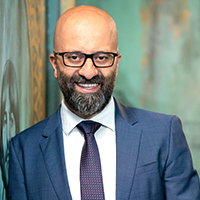‘Customer Experience’ was once considered a buzzword by many businesses. Some considered it to be a passing fad while others were unclear on how to apply the concept. However, it has quickly become one of most critical differentiators for companies today. No matter what the industry, the better the customer experience, the more customers the business will attract and retain.
Which is why over the past decade, a wide range of businesses have started to place a greater focus on empathising with their customers. This has made room for a critical role within the leadership team – the Chief Experience Officer (CXO), also known as the Chief Customer Officer (CCO).
Rise of the CXO – the customers’ champion
The role of patient's champion evolved as a result of shifting consumer behaviours and expectations. The CPXO has quickly grown to become critical for medical practices across the globe.
Virgin Australia was among the first to implement the role, and its CXO, Mark Hassell has since overseen an overhaul of many of the airline’s operating procedures, including the flight booking system itself – all in the name of making things easier for the customer.
"[The role is] 'to be the customers’ champion within the business: the conscience, and their eyes and ears'. It is to understand the psyche of the people who are considering giving you a go, who are trialing you, becoming loyalists, and then advocates. It is about having the head and heart of customer in the executive group to shape the business." – Mark Hassell, CXO of Virgin Australia
The need for a Chief Patient Experience Officer in health care
With our population booming and healthcare demand on the rise, many clinics have been forced to focus on maximising the volume of patients in and out of their doors. It’s becoming a numbers game at the cost of the individual patient experience, this model of healthcare is unsustainable and needs addressing.
From the moment a patient interacts with a clinic, be it through their website or on the phone, until the end of their care journey, there are multiple touch points, interactions and transactions that take place with a vast number of clinic staff.
However, very few team members give sustained thought to how their individual interactions with a patient shape the full experience; and there is typically no executive role that unifies everyone’s efforts across the patient journey. This ultimately dilutes the overall experience and can lead to a lower patient retention rates, which in turn impact the bottom line of the clinic.
It’s time for a reset in healthcare. With added pressures from well-informed patients and Australian legislation moving toward payment models based on value and patient satisfaction, not just fee-for-service; clinics need to follow in the footsteps of forward-thinking industries and appoint a patient champion – a Chief Patient Experience Officer (CPXO).
The Cleveland Clinic case study
Cleveland Clinic in the United States took the lead with their first ever CPXO, James Merlino MD., being appointed back in 2009. Merlino set about changing workplace culture, starting with the way staff communicate with patients. This included the re-labelling of staff as caregivers no matter what their specific role – a small change, but the simple reframing made a big difference to the way staff saw themselves.
The clinic established a committee to develop a manual of best practices when it came to interacting with patients. Within three years, Merlino took Cleveland Clinic from the bottom of the pile in terms of patient satisfaction to the top.
Clinics need to enable a single individual who is not overburdened with clinical duties and can work closely with the other executives in the business to champion the patient experience. The CPXO’s relationship with CIOs or CTOs is imperative given the relationship that technology plays in assisting clinicians and support staff to minimise inefficiencies and provide an effortless patient experience.
The role of the CPXO in the boardroom and beyond
The role of the Chief Patient Experience Officer is to create and implement a healthcare delivery system that consistently meets or exceeds patient expectations. The CPXO’s responsibilities should ultimately include the following:
1. Develop an organisational patient experience strategy
The process of providing positive patient experiences never stops – and that’s why it’s important to always think big picture, track your progress, and think about the next step. Your CPXO should work with executives to identify the key performance indicators (KPIs) for all patient experience actions, then track and review these. KPIs can range from patient satisfaction surveys, to the time spent by physicians on admin tasks compared to patient time.
This strategy should include clear objectives and performance benchmarks, allowing a baseline for frequent review. The CPXO would then take reports driven by data and work with teams to identify areas for improvement.
2. Bridge the gap between executives and the frontline
The role of the CPXO is to view process and performance improvement through the lens of the patient, and relay it back to the executive team to gain their buy in. From there, the CPXO takes charge of bringing that vision to the entire clinic staff, and providing the tools and support systems to implement it. Having a CPXO oversee this has the added benefit of sending a message to all staff that patient satisfaction comes first, and gives a sense of accountability for making it happen.
3. Empower teams and prevent burnout
Although the focus is on patient care and satisfaction, the CPXO must also consider aspects of staff management. If staff are to provide optimal care and compassion, they also need to take care of their own physical and mental health. That’s why the CPXO must also consider strategies to prevent burnout and support staff through difficulties.
4. Review processes and systems to promote efficiency
Providing better experiences for patients starts by ensuring the right people receive the right information at the right time. If your practice efficiency and information flow improves, your team will have more time to focus on what’s important: patient care. A CPXO must work closely with senior executives to identify the primary motivations and collaborate with front line staff to better understand on-the-ground systems.
Cloud-based practice management solutions can equip your practice with a patient portal for easy and secure information sharing between teams. Meanwhile, defining workflows for physicians can help your CPXO understand which parts of the process can be streamlined to save everyone time, such as asking patients to fill pre-appointment forms with their basic health information, symptoms, and so on.
5. Open the conversation
Providing a positive patient experience is the responsibility of everyone in your team – not just of your CPXO and executive team. Therefore, it’s important for your team to come together, discuss the patient experience, and contribute ideas on how the patient experience can be improved.
Over to you
As healthcare moves forward, the role of the CPXO will be well and truly cemented in the executive team. Putting the patient first will allow both doctor and patient to gain more from the relationship. Patients receive a higher standard of care and empathy, and clinicians get a greater sense of satisfaction and purpose – a winning situation all around.
With a quality patient experience ensured and clinician satisfaction rates raised, your practice benefits from increased patient loyalty and positive word of mouth – ultimately, this leads to tangible benefits to the financial performance of your clinic. Using insights from thousands of Australian medical organisations, we’ve created an essential ebook for boosting financial performance. Download your complimentary copy today by clicking the image below.
Clinic to Cloud does not provide tax, legal or accounting advice. This material is for informational purposes only and is not a substitute for independent professional advice. You should consult your own tax, legal and accounting advisors before engaging in any transaction. See the Clinic to Cloud Disclaimer for further information.




